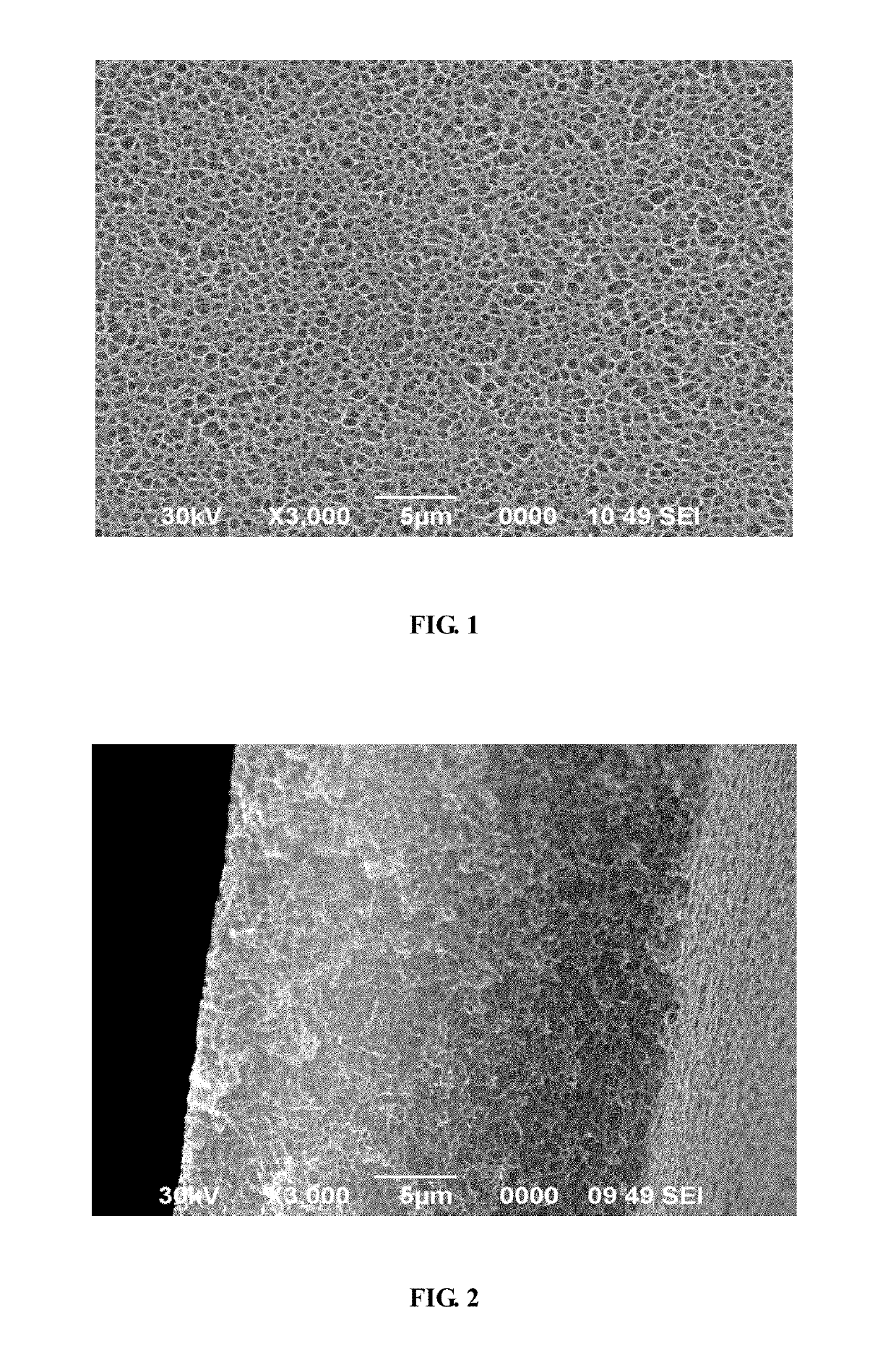Method for preparing aromatic polyamide porous membrane and aromatic polyamide porous membrane prepared thereby
a technology of aromatic polyamide and porous membrane, which is applied in the field of preparation of aromatic polyamide porous membrane, can solve the problems of high production cost and environmental pollution, complex separation of additives, and difficult recycling of additives, and achieves easy control, good dissolving ability, and easy yield
- Summary
- Abstract
- Description
- Claims
- Application Information
AI Technical Summary
Benefits of technology
Problems solved by technology
Method used
Image
Examples
embodiment 1
[0040]First, polymerizing in a reaction tank to obtain a poly (m-phenylene isophthalamide) solution 2000 g, wherein DMAC acting as the solvent, and a mass percentage concentration of the polymer is 20%. Second, mixing 800 g of 1-methyl-3-butyl imidazolinium hydrochloride with 240 g of anhydrous ethanol in a stirred tank to obtain an ionic liquid solution. Third, injecting the ionic liquid solution and the poly (m-phenylene isophthalamide) solution into a twin-screw extruder at a mass ratio of 1:1.8, and mixing dispersively therein to obtain a uniform mixture. After that, extruding the uniform mixture at a die-head by a melt pump into a coagulation bath to obtain a thin-film, wherein the coagulation bath being a mixed solvents of water and DMAC, a mass fraction of water is 50%, a temperature of the coagulation bath being 80° C. and a gel time thereof being 20 seconds. Next, pulling the thin-film into an extraction tank, wherein a temperature of the extraction tank being 30° C. And th...
embodiment 2
[0041]First, polymerizing by twin-screw to obtain a poly (m-phenylene isophthalamide) solution 2400 g, wherein DMAC acting as a solvent, and a mass percentage concentration of the polymer is 20%. Second, mixing 1000 g of methyl triethylammonium acetate and 200 g of deionized water uniformly in a stirred tank to obtain an ionic liquid solution, wherein the stirred tank being heated to 50° C. Third, injecting the obtained ionic liquid solution and the poly (m-phenylene isophthalamide) solution separately into a twin-screw extruder at a mass ratio of 1:1.5, and mixing dispersively therein to obtain a uniform mixture. After that, extruding the uniform mixture at a die-head by a melt pump into a coagulation bath to obtain a thin-film, wherein the coagulation bath being a mixed solvents of water and DMAC, a mass fraction of water in the coagulation bath is 20%, a temperature of the coagulation bath being 60° C. and a gel time thereof being 5 seconds. Next, pulling the thin-film into an ex...
embodiment 3
[0042]Embodiment 3 is similar with embodiment 2, and the difference lies in that, a mass of deionized water which is mixed with methyl triethylammonium acetate is 50 g, and the permeability of the porous membrane is 110 sec. / 100 CC.
PUM
| Property | Measurement | Unit |
|---|---|---|
| mass fraction | aaaaa | aaaaa |
| mass fraction | aaaaa | aaaaa |
| mass fraction | aaaaa | aaaaa |
Abstract
Description
Claims
Application Information
 Login to View More
Login to View More - R&D
- Intellectual Property
- Life Sciences
- Materials
- Tech Scout
- Unparalleled Data Quality
- Higher Quality Content
- 60% Fewer Hallucinations
Browse by: Latest US Patents, China's latest patents, Technical Efficacy Thesaurus, Application Domain, Technology Topic, Popular Technical Reports.
© 2025 PatSnap. All rights reserved.Legal|Privacy policy|Modern Slavery Act Transparency Statement|Sitemap|About US| Contact US: help@patsnap.com


